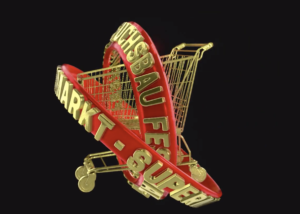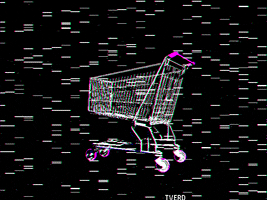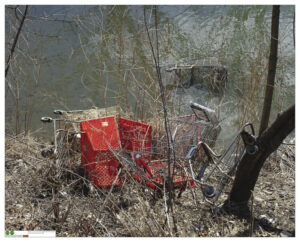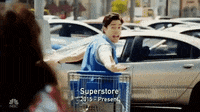The Shopping Cart as a two-fold symbol of consumption
The Shopping Cart
By Eric, Suzan, Vladimir and Paul


When we go shopping, the first thing many consumers do is to get a shopping cart. Invented in the 1930s by a supermarket chain owner who was thinking about a way for allowing his customers to move more groceries, it became a must in every supermarket and a key part of the customer experience in many shops. The item became a very popular, if not the most popular symbol for shopping and an increasingly consumerist society. This association makes us understand how deeply this item is rooted in our minds. It is interesting to notice how easily we take this item for granted and think about how upsetting it would be for each of us to enter a supermarket, not being able to find a shopping cart.
Since its invention, the shopping cart has been innovated repeatedly in order to be more practical, more efficient, more appealing, and easy to use. We can now see shopping carts with funny cars into which we can put our children, others with compartments for our pets, different shapes, sizes, and features. Innovations affected the usage and the comfort of the carts, however, with the advent of the internet and e-shops even the meaning of the “shopping cart” was extended: we now indicate not only the physical cart with wheels as a shopping cart but also the list of the items we want to buy online.
Even during the COVID-19 crisis, when the consumers’ behavior significantly changed very quickly and this simple item might become a way to contract the virus, it remains a cornerstone of our shopping experience and is used as a tool to respect social distancing. We decided to focus on this artifact because it is a simple but at the same time important and representative item that is continuously evolving, while remaining a crucial element of the shopping experience of every customer – online or offline.
The analog shopping cart

Shopping as both procurement of necessary goods and as a leisurely pastime is supported by easing the burden of transporting the goods around the store. While the buying could provide their own technology, method or tool to transport these goods, the norm is that the store is the provider of that ‘vehicle’ within the bounds of the physical space belonging to the store; around the store, to the registry and even on outside, as far as the lot restricted by the private property limit of the given seller. The shopping basket and shopping cart is the vehicle that supports this easing.
While it is made in many different designs, it is usually a gridded container, where customers can place objects. They are often provided with wheels, and are made in versions for parents, that allow children seating, and in motorized versions to help people with physical challenges. It negotiates a limit of products that the customer might buy: If there was no cart, customers could only buy what they could carry. Small carts can only be filled to a certain degree, and large carts enable larger purchases.
Often the shopping cart is made of cheap materials to avoid embedding it with inherent value. Some even require tokens or small deposits to unlock to avoid theft. We rarely see people away from a store with a shopping cart. In this way, we can see that their inherent function is only normalized within the store, even though it has the same function as a helping/carrying vehicle outside the store.

While shopping carts help us transform generic goods into a personalized choice, they are not in themselves a personal item. In the store, they are passed from owner to owner, once they have fulfilled their purpose. This both signifies them as enablers of economic transactions rather than part of the economy itself, and also signifies the impersonal nature of supporting technologies. While this impersonal nature is part of its functionality, it also means that the former or future use is not a part of the mental landscape and the bacteria that they pass on by, is rarely considered.
Since the pandemic, this technology has gained much attention as customers are often required to use them in order to maintain distance and shopping carts regulate the amount of customers in some stores. This change of policies will be one of our starting points for a further exploration of the topic.
The digital shopping cart and the birth of online shopping
As the analog shopping carts filled with toilet paper and pasta were one of the many symbolic images of the current pandemic in some countries, people did not only fill their analog shopping carts with goods, but also their digital shopping carts in online shops. According to TechCrunch, e-commerce has increased in sales by 49% in April, with online grocery shopping jumping up by 110%.
The option of online shopping was developed in the early stages of the internet, making it possible to assemble items in a digital shopping cart list in order to checkout with a computer processed payment once one has finished shopping. Nowadays, almost everything can be ordered online as items are shipped from many places in the world directly to the buyer’s doorstep. And since the analog shopping cart has become symbolic for the act of shopping in many parts of the world, the symbol of the cart has been adapted to the buttons in online shops, that users have to click in order to add something to their digital cart.

Since there is a digital and an analog version of the shopping cart, we decided to explore both of these dimensions during the next few days. Both versions have been adapted with various innovations during the past decades, one example being Amazon’s patent of the 1-Click technique to enable faster buying procedures. As both versions of the shopping cart are experiencing an increase in usage and symbolic meaning during the current pandemic, we want to investigate the structuring aspects of the (two) technologies. Furthermore, the lines between the analog and the digital shopping cart are blurring, as physical shopping carts in supermarkets are equipped with interface and scanning devices and scales to enable self checkout shopping.
One similarity between the two, we have already found out about, is that both versions of the shopping cart are often abandoned. While most people probably know the experience of filling an online shopping cart with various items and then leaving the web page without buying them, physical shopping carts are often found in ditches, bushes or at the beach. This phenomenon has been documented by the artist Julian Montague, collaging abandoned shopping carts in his book and exhibition “The Stray Shopping Carts Of Eastern North America: A Guide to Field Identification.”

However, racing with online shopping carts doesn’t seem to be possible just yet.
